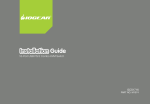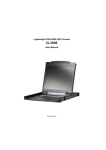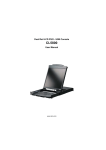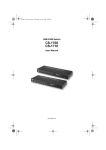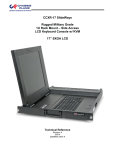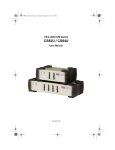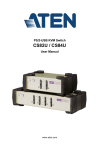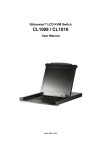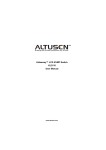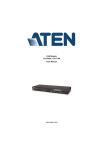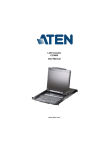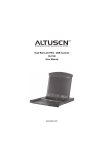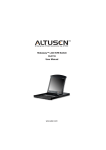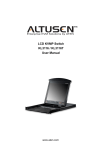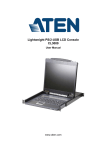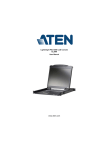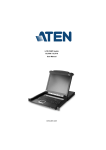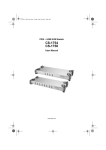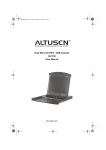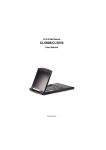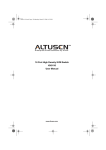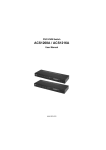Download ATEN Technology CL1308 User's Manual
Transcript
LCD KVM Switch CL1308 / CL1316 User Manual www.aten.com CL1308 / CL1316 User Manual FCC, CE Information FEDERAL COMMUNICATIONS COMMISSION INTERFERENCE STATEMENT: This equipment has been tested and found to comply with the limits for a Class A digital device, pursuant to Part 15 of the FCC Rules. These limits are designed to provide reasonable protection against harmful interference when the equipment is operated in a commercial environment. This equipment generates, uses, and can radiate radio frequency energy and, if not installed and used in accordance with the instruction manual, may cause harmful interference to radio communications. Operation of this equipment in a residential area is likely to cause harmful interference in which case the user will be required to correct the interference at his own expense. FCC Caution: Any changes or modifications not expressly approved by the party responsible for compliance could void the user's authority to operate this equipment. CE Warning: This is a class A product. In a domestic environment this product may cause radio interference in which case the user may be required to take adequate measures. RoHS This product is RoHS compliant. SJ/T 11364-2006 The following contains information that relates to China. ii CL1308 / CL1316 User Manual User Information Online Registration Be sure to register your product at our online support center: International http://eservice.aten.com Telephone Support For telephone support, call this number: International 886-2-8692-6959 China 86-10-5255-0110 Japan 81-3-5615-5811 Korea 82-2-467-6789 North America 1-888-999-ATEN ext 4988 United Kingdom 44-8-4481-58923 User Notice All information, documentation, and specifications contained in this manual are subject to change without prior notification by the manufacturer. The manufacturer makes no representations or warranties, either expressed or implied, with respect to the contents hereof and specifically disclaims any warranties as to merchantability or fitness for any particular purpose. Any of the manufacturer's software described in this manual is sold or licensed as is. Should the programs prove defective following their purchase, the buyer (and not the manufacturer, its distributor, or its dealer), assumes the entire cost of all necessary servicing, repair and any incidental or consequential damages resulting from any defect in the software. The manufacturer of this system is not responsible for any radio and/or TV interference caused by unauthorized modifications to this device. It is the responsibility of the user to correct such interference. The manufacturer is not responsible for any damage incurred in the operation of this system if the correct operational voltage setting was not selected prior to operation. PLEASE VERIFY THAT THE VOLTAGE SETTING IS CORRECT BEFORE USE. iii CL1308 / CL1316 User Manual Package Contents The CL1308 / CL1316 package consists of: 1 CL1308 / CL1316 LCD KVM Switch with Rack Mount Kit 1 Power Cord 2 Custom KVM Cables 1 Firmware Upgrade cable 1 User Instructions* Check to make sure that all the components are present and that nothing got damaged in shipping. If you encounter a problem, contact your dealer. Read this manual thoroughly and follow the installation and operation procedures carefully to prevent any damage to the unit, and/or any of the devices connected to it. * Features may have been added to the CL1308 / CL1316 since this manual was published. Please visit our website to download the most up-to-date version of the manual. © Copyright 2014 ATEN® International Co., Ltd. Manual Part No. F/W Version: V1.0.072 Manual Date: 2014-06-25 ATEN and the ATEN logo are registered trademarks of ATEN International Co., Ltd. All rights reserved. All other brand names and trademarks are the registered property of their respective owners. iv CL1308 / CL1316 User Manual Contents FCC, CE Information. . . . . . . . . . . . . . . . . . . . . . . . . . . . . . . . . . . . . . . . . . ii RoHS. . . . . . . . . . . . . . . . . . . . . . . . . . . . . . . . . . . . . . . . . . . . . . . . . . . . . . ii SJ/T 11364-2006. . . . . . . . . . . . . . . . . . . . . . . . . . . . . . . . . . . . . . . . . . . . . ii User Information . . . . . . . . . . . . . . . . . . . . . . . . . . . . . . . . . . . . . . . . . . . . .iii Online Registration . . . . . . . . . . . . . . . . . . . . . . . . . . . . . . . . . . . . . . . .iii Telephone Support . . . . . . . . . . . . . . . . . . . . . . . . . . . . . . . . . . . . . . . .iii User Notice . . . . . . . . . . . . . . . . . . . . . . . . . . . . . . . . . . . . . . . . . . . . . .iii Package Contents. . . . . . . . . . . . . . . . . . . . . . . . . . . . . . . . . . . . . . . . . . . iv About this Manual . . . . . . . . . . . . . . . . . . . . . . . . . . . . . . . . . . . . . . . . . . .viii Conventions . . . . . . . . . . . . . . . . . . . . . . . . . . . . . . . . . . . . . . . . . . . . . . . ix Product Information. . . . . . . . . . . . . . . . . . . . . . . . . . . . . . . . . . . . . . . . . . ix 1. Introduction Overview . . . . . . . . . . . . . . . . . . . . . . . . . . . . . . . . . . . . . . . . . . . . . . . . . . . 1 Features . . . . . . . . . . . . . . . . . . . . . . . . . . . . . . . . . . . . . . . . . . . . . . . . . . . 2 Requirements . . . . . . . . . . . . . . . . . . . . . . . . . . . . . . . . . . . . . . . . . . . . . . . 3 Computers . . . . . . . . . . . . . . . . . . . . . . . . . . . . . . . . . . . . . . . . . . . . . . . 3 Cables . . . . . . . . . . . . . . . . . . . . . . . . . . . . . . . . . . . . . . . . . . . . . . . . . . 3 Operating Systems . . . . . . . . . . . . . . . . . . . . . . . . . . . . . . . . . . . . . . . . 4 Components . . . . . . . . . . . . . . . . . . . . . . . . . . . . . . . . . . . . . . . . . . . . . . . . 5 Front View . . . . . . . . . . . . . . . . . . . . . . . . . . . . . . . . . . . . . . . . . . . . . . . 5 Rear View . . . . . . . . . . . . . . . . . . . . . . . . . . . . . . . . . . . . . . . . . . . . . . . 7 2. Hardware Setup Overview . . . . . . . . . . . . . . . . . . . . . . . . . . . . . . . . . . . . . . . . . . . . . . . . . . . 9 Before you Begin. . . . . . . . . . . . . . . . . . . . . . . . . . . . . . . . . . . . . . . . . . . . . 9 Standard Rack Mounting. . . . . . . . . . . . . . . . . . . . . . . . . . . . . . . . . . . . . . 10 Grounding . . . . . . . . . . . . . . . . . . . . . . . . . . . . . . . . . . . . . . . . . . . . . . . . . 12 Single Level Installation . . . . . . . . . . . . . . . . . . . . . . . . . . . . . . . . . . . . . . 13 Cable Connection Diagrams . . . . . . . . . . . . . . . . . . . . . . . . . . . . . . . . . . . 14 Two Level Installation . . . . . . . . . . . . . . . . . . . . . . . . . . . . . . . . . . . . . . . . 15 3. Basic Operation Opening the Console . . . . . . . . . . . . . . . . . . . . . . . . . . . . . . . . . . . . . . . . 17 Closing the Console . . . . . . . . . . . . . . . . . . . . . . . . . . . . . . . . . . . . . . . . . 18 Operating Precautions . . . . . . . . . . . . . . . . . . . . . . . . . . . . . . . . . . . . . . . 19 Powering Off and Restarting . . . . . . . . . . . . . . . . . . . . . . . . . . . . . . . . . . . 20 LCD OSD Configuration . . . . . . . . . . . . . . . . . . . . . . . . . . . . . . . . . . . . . . 21 The LCD Buttons . . . . . . . . . . . . . . . . . . . . . . . . . . . . . . . . . . . . . . . . . 21 LCD Adjustment Settings . . . . . . . . . . . . . . . . . . . . . . . . . . . . . . . . . . 22 Hot Plugging . . . . . . . . . . . . . . . . . . . . . . . . . . . . . . . . . . . . . . . . . . . . . . . 23 Hot Plugging KVM Ports . . . . . . . . . . . . . . . . . . . . . . . . . . . . . . . . . . . 23 Port Selection . . . . . . . . . . . . . . . . . . . . . . . . . . . . . . . . . . . . . . . . . . . . . . 23 Manual Port Switching. . . . . . . . . . . . . . . . . . . . . . . . . . . . . . . . . . . . . 23 Port ID Numbering . . . . . . . . . . . . . . . . . . . . . . . . . . . . . . . . . . . . . . . . . . 24 v CL1308 / CL1316 User Manual 4. OSD Operation OSD Overview . . . . . . . . . . . . . . . . . . . . . . . . . . . . . . . . . . . . . . . . . . . . . 25 OSD Login. . . . . . . . . . . . . . . . . . . . . . . . . . . . . . . . . . . . . . . . . . . . . . 25 OSD Hotkey . . . . . . . . . . . . . . . . . . . . . . . . . . . . . . . . . . . . . . . . . . . . 25 OSD Main Screen . . . . . . . . . . . . . . . . . . . . . . . . . . . . . . . . . . . . . . . . 26 OSD Main Screen Headings . . . . . . . . . . . . . . . . . . . . . . . . . . . . . . . . 26 OSD Navigation . . . . . . . . . . . . . . . . . . . . . . . . . . . . . . . . . . . . . . . . . 27 OSD Functions . . . . . . . . . . . . . . . . . . . . . . . . . . . . . . . . . . . . . . . . . . . . . 27 F1: GOTO . . . . . . . . . . . . . . . . . . . . . . . . . . . . . . . . . . . . . . . . . . . . . . 28 F2: LIST . . . . . . . . . . . . . . . . . . . . . . . . . . . . . . . . . . . . . . . . . . . . . . . 28 F3: SET . . . . . . . . . . . . . . . . . . . . . . . . . . . . . . . . . . . . . . . . . . . . . . . . 29 F4: ADM . . . . . . . . . . . . . . . . . . . . . . . . . . . . . . . . . . . . . . . . . . . . . . . 31 F5: SKP. . . . . . . . . . . . . . . . . . . . . . . . . . . . . . . . . . . . . . . . . . . . . . . . 34 F6: BRC . . . . . . . . . . . . . . . . . . . . . . . . . . . . . . . . . . . . . . . . . . . . . . . 34 F7: SCAN . . . . . . . . . . . . . . . . . . . . . . . . . . . . . . . . . . . . . . . . . . . . . . 35 F8: LOUT . . . . . . . . . . . . . . . . . . . . . . . . . . . . . . . . . . . . . . . . . . . . . . 36 5. Keyboard Port Operation Hotkey Port Control . . . . . . . . . . . . . . . . . . . . . . . . . . . . . . . . . . . . . . . . . 37 Invoke Hotkey Mode . . . . . . . . . . . . . . . . . . . . . . . . . . . . . . . . . . . . . . . . . 37 Number Lock and Minus Keys . . . . . . . . . . . . . . . . . . . . . . . . . . . 37 Control and F12 Keys . . . . . . . . . . . . . . . . . . . . . . . . . . . . . . . . . . 38 Select the Active Port . . . . . . . . . . . . . . . . . . . . . . . . . . . . . . . . . . . . . . . . 38 Auto Scan Mode . . . . . . . . . . . . . . . . . . . . . . . . . . . . . . . . . . . . . . . . . . . . 39 Invoking Auto Scan: . . . . . . . . . . . . . . . . . . . . . . . . . . . . . . . . . . . . . . 39 Skip Mode. . . . . . . . . . . . . . . . . . . . . . . . . . . . . . . . . . . . . . . . . . . . . . . . . 40 Computer Keyboard / Mouse Reset . . . . . . . . . . . . . . . . . . . . . . . . . . . . . 41 Hotkey Beeper Control . . . . . . . . . . . . . . . . . . . . . . . . . . . . . . . . . . . . . . . 41 Quick Hotkey Control . . . . . . . . . . . . . . . . . . . . . . . . . . . . . . . . . . . . . . . . 42 OSD Hotkey Control . . . . . . . . . . . . . . . . . . . . . . . . . . . . . . . . . . . . . . . . . 42 Port OS Control . . . . . . . . . . . . . . . . . . . . . . . . . . . . . . . . . . . . . . . . . . . . 43 Restore Default Values. . . . . . . . . . . . . . . . . . . . . . . . . . . . . . . . . . . . . . . 43 Hotkey Summary Table . . . . . . . . . . . . . . . . . . . . . . . . . . . . . . . . . . . . . . 44 6. The Firmware Upgrade Utility Introduction . . . . . . . . . . . . . . . . . . . . . . . . . . . . . . . . . . . . . . . . . . . . . . . . 45 Downloading the Firmware Upgrade Package . . . . . . . . . . . . . . . . . . 45 Preparation . . . . . . . . . . . . . . . . . . . . . . . . . . . . . . . . . . . . . . . . . . . . . . . . 46 Starting the Upgrade. . . . . . . . . . . . . . . . . . . . . . . . . . . . . . . . . . . . . . . . . 47 Upgrade Succeeded . . . . . . . . . . . . . . . . . . . . . . . . . . . . . . . . . . . . . . . . . 49 Upgrade Failed . . . . . . . . . . . . . . . . . . . . . . . . . . . . . . . . . . . . . . . . . . . . . 49 Firmware Upgrade Recovery . . . . . . . . . . . . . . . . . . . . . . . . . . . . . . . . . . 50 7. Keyboard Emulation Mac Keyboard. . . . . . . . . . . . . . . . . . . . . . . . . . . . . . . . . . . . . . . . . . . . . . 51 Sun Keyboard . . . . . . . . . . . . . . . . . . . . . . . . . . . . . . . . . . . . . . . . . . . . . . 52 vi CL1308 / CL1316 User Manual Appendix Safety Instructions. . . . . . . . . . . . . . . . . . . . . . . . . . . . . . . . . . . . . . . . . . . 53 General . . . . . . . . . . . . . . . . . . . . . . . . . . . . . . . . . . . . . . . . . . . . . . . . 53 Rack Mounting . . . . . . . . . . . . . . . . . . . . . . . . . . . . . . . . . . . . . . . . . . 55 Consignes de sécurité. . . . . . . . . . . . . . . . . . . . . . . . . . . . . . . . . . . . . . . . 56 Général . . . . . . . . . . . . . . . . . . . . . . . . . . . . . . . . . . . . . . . . . . . . . . . . 56 Montage sur bâti . . . . . . . . . . . . . . . . . . . . . . . . . . . . . . . . . . . . . . . . . 58 Technical Support . . . . . . . . . . . . . . . . . . . . . . . . . . . . . . . . . . . . . . . . . . . 60 International. . . . . . . . . . . . . . . . . . . . . . . . . . . . . . . . . . . . . . . . . . . . . 60 North America . . . . . . . . . . . . . . . . . . . . . . . . . . . . . . . . . . . . . . . . . . . 60 Specifications . . . . . . . . . . . . . . . . . . . . . . . . . . . . . . . . . . . . . . . . . . . . . . 61 Connection Tables . . . . . . . . . . . . . . . . . . . . . . . . . . . . . . . . . . . . . . . . . . 62 CL1308 to Compatible 8-Port Switches . . . . . . . . . . . . . . . . . . . . . . . 62 CL1308 to Compatible 16-Port Switches . . . . . . . . . . . . . . . . . . . . . . 62 CL1316 to Compatible 8-Port Switches . . . . . . . . . . . . . . . . . . . . . . . 62 CL1316 to Compatible 16-Port Switches . . . . . . . . . . . . . . . . . . . . . . 62 Supported KVM Switches . . . . . . . . . . . . . . . . . . . . . . . . . . . . . . . . . . . . . 63 OSD Factory Default Settings . . . . . . . . . . . . . . . . . . . . . . . . . . . . . . . . . . 64 Optional Rack Mounting . . . . . . . . . . . . . . . . . . . . . . . . . . . . . . . . . . . . . . 65 Standard - Long . . . . . . . . . . . . . . . . . . . . . . . . . . . . . . . . . . . . . . . 65 Easy Installation. . . . . . . . . . . . . . . . . . . . . . . . . . . . . . . . . . . . . . . 65 About SPHD Connectors . . . . . . . . . . . . . . . . . . . . . . . . . . . . . . . . . . . . . 68 Troubleshooting . . . . . . . . . . . . . . . . . . . . . . . . . . . . . . . . . . . . . . . . . . . . 69 Limited Warranty . . . . . . . . . . . . . . . . . . . . . . . . . . . . . . . . . . . . . . . . . . . . 69 vii CL1308 / CL1316 User Manual About this Manual This user manual is provided to help you get the most from your CL1308 / CL1316 system. It covers all aspects of installation, configuration and operation. An overview of the information found in the manual is provided below. Chapter 1, Introduction, introduces you to the CL1308 / CL1316 system. Its purpose, features and benefits are presented, and its front and back panel components are described. Chapter 2, Hardware Setup, describes how to set up your installation. The necessary steps – from a basic single level hookup to a complete 17-switch two level operation are provided. Chapter 3, Basic Operation, explains the fundamental concepts involved in operating the CL1308 / CL1316. Chapter 4, OSD Operation, provides a complete description of the CL1308 / CL1316 OSD (on-screen display), and how to work with it. Chapter 5, Keyboard Port Operation, details all of the concepts and procedures involved in the hotkey operation of your CL1308 / CL1316 installation. Chapter 7, Keyboard Emulation, provides tables that list the PC to Mac and PC to Sun keyboard emulation mappings. Chapter 6, The Firmware Upgrade Utility, explains how to use this utility to upgrade the CL1308 / CL1316 firmware with the latest available versions. An Appendix, provides specifications and other technical information regarding the CL1308 / CL1316. viii CL1308 / CL1316 User Manual Conventions This manual uses the following conventions: Monospaced Indicates text that you should key in. [] Indicates keys you should press. For example, [Enter] means to press the Enter key. If keys need to be chorded, they appear together in the same bracket with a plus sign between them: [Ctrl+Alt]. 1. Numbered lists represent procedures with sequential steps. ♦ Bullet lists provide information, but do not involve sequential steps. → Indicates selecting the option (on a menu or dialog box, for example), that comes next. For example, Start → Run means to open the Start menu, and then select Run. Indicates critical information. Product Information For information about all ATEN products and how they can help you connect without limits, visit ATEN on the Web or contact an ATEN Authorized Reseller. Visit ATEN on the Web for a list of locations and telephone numbers: International http://www.aten.com North America http://www.aten-usa.com ix CL1308 / CL1316 User Manual This Page Intentionally Left Blank x Chapter 1 Introduction Overview The CL1308 / CL1316 LCD KVM Switch features an integrated 19" LCD panel allowing access and control with up to 8 or 16 computers from a single console (keyboard, mouse, and monitor). As many as 8 (CL1308) or 16 (CL1316) additional switches can be cascaded bringing the total number of connected computers to 128 (CL1308) or 256 (CL1316) computers that can be controlled from a single keyboard-monitor-mouse console. Additionally, the CL1308 / CL1316 features a compact design that allows installation in a 1U system rack. Setup is fast and easy; plugging cables into their appropriate ports is all that is needed. The switch supports both USB and PS/2 connections for the console and computers. The CL1308 / CL1316 intercepts keyboard input directly, thus eliminating the need for any software configuration. Switching between computers can be easily accomplished either by manually pressing the front panel push button port LEDs, entering hotkey combinations from the keyboard, or via a menu driven multilingual on-screen display (OSD) system. A convenient auto-scan feature permits automatic scanning and monitoring of activities on all connected computers. Lastly, the CL1308 / CL1316 offers the following additional benefits: a) integrated 19” LCD, keyboard and mouse console, b) managing 8/16 computers from a single console, c) eliminating the expense of having to purchase a separate keyboard, monitor, and mouse for each computer, d) space and energy costs savings, and d) creates a greener environment by reducing energy waste. 1 CL1308 / CL1316 User Manual Features A single console controls up to 128 (CL1308) or 256 (CL1316) computers Integrated KVM console with 19” LCD panel Cascade to 2 levels – connect up to 8 (CL1308) or 16 (CL1316) switches Dual Interface – supports computers with PS/2 or USB keyboards and mice Multiplatform support – Windows 2000/XP/Vista, Linux, Mac, and Sun Supports USB keyboards for PC, Mac and Sun Auto PS/2 and USB interface detection USB or PS/2 keyboard and mouse emulation – computers boot even when the console focus is elsewhere Superior video quality – up to 1280 x 1024 @ 75 Hz; DDC2B Convenient computer switching via front panel pushbuttons, hotkeys, or multilingual on-screen display (OSD) menu Two level password security - only authorized users view and control computers; up to four users and an administrator with a separate profile for each Auto Scan feature for monitoring user-selected computers Broadcast mode – operations simultaneously performed on all selected computers Hot pluggable – add or remove computers without having to power down the switch Buzzer on/off via hotkey and OSD Firmware upgradeable No software installation required Rack mountable 2 Chapter 1. Introduction Requirements Computers The following hardware components are required for each computer: A VGA, SVGA, or multisync video graphics card with an HDB-15 port. PS/2 mouse and keyboard ports (6-pin Mini-DIN), or at least one USB port. Cables Substandard cables might damage the connected devices or degrade overall performance. For optimum signal integrity and to simplify the layout use the high quality custom cable sets described below. Function KVM switch to computer Length Part Number PS/2 1.2 m 1.8 m 3.0 m 6.0 m 1.8 m 2L-5201P 2L-5202P 2L-5203P 2L-5206P 2L-5702P USB 1.2 m 1.8 m 3.0 m 5.0 m 2L-5201U 2L-5202U 2L-5203U 2L-5205U USB and PS/2 1.2 m 1.8 m 3.0 m 2L-5301UP 2L-5302UP 2L-5303UP 3 CL1308 / CL1316 User Manual Operating Systems Supported operating systems are shown in the table, below: OS Windows Linux UNIX 2000 and higher RedHat 7.1 and higher SuSE 8.2 and higher Mandriva (Mandrake) 9.0 and higher AIX 4.3 and higher FreeBSD Sun Novell Mac 4 Version Netware 4.2 and higher Solaris 8 and higher 5.0 and higher OS 9 and higher Chapter 1. Introduction Components Front View 2 1 3 2 4 5 6 13 7 12 8 11 9 10 Note: The CL1316 is pictured in the diagrams of this chapter. However, the CL1308 is the same as the CL1316, except that it has 8 KVM ports. 5 CL1308 / CL1316 User Manual No. Component Description 1 Handle Pull to slide the KVM module out; push to slide the module in (see item 2 in this table). 2 Slide Release In order to slide the console out, you must first release it by sliding these tabs to the inside. See page 17 for details on sliding the console in and out. 3 LCD Display After sliding the KVM module out, flip up the cover to access the LCD monitor. 4 LCD Controls The LCD On/Off switch is located here, as well as buttons to control the position and picture settings of the LCD display. See page 21 for details. 5 Port LEDs An orange ON LINE LED lights to indicate that the computer attached to its corresponding port is up and running. A green Selected LED lights to indicate that the computer attached to the corresponding port is selected for KVM control. 6 Keyboard Standard 105-key keyboard 7 Touchpad Standard mouse touchpad 8 Port Switches Press the port pushbuttons to bring the KVM focus to the computer attached to the corresponding port. 9 Power LED Lights to indicate that the unit is receiving power. 10 Rack Mounting Brackets The rack mount brackets located at each corner of the unit secure the chassis to a system rack. 11 Lock LEDs Num Lock, Caps Lock, Scroll Lock LEDs are located here. 12 Reset Switch Located to the right of the Lock LEDs. Press this recessed switch in with a small object to perform a system reset. 13 Firmware Upgrade Section Firmware Upgrade Port: The Firmware Upgrade Cable that transfers the firmware upgrade data from the administrator's computer to the CL1308 / CL1316 plugs into this RJ-11 connector. Firmware Upgrade Switch: During normal operation this switch should be in the NORMAL position. (See The Firmware Upgrade Utility, page 45 for firmware upgrading details.) 6 Chapter 1. Introduction Rear View 1 2 3 4 Note: The CL1316 is pictured above. The CL1308 rear panel is the same as the CL1316, except that it has 8 KVM ports instead of 16. No. Component Description 1 Power Socket This is a standard 3-prong AC power socket. The power cord from an AC source plugs in here. 2 Power Switch This standard rocker switch powers the unit on and off. 3 KVM Port Section The cables that link to the computers plug in here. Grounding Terminal The grounding wire used to ground the switch attaches here. 4 Note: The shape of these SPHD connectors have been specifically modified so that only KVM cables designed to work with this switch can plug in (see the Cables section on page 3, for details). Do NOT attempt to use ordinary 15 pin VGA connector cables to link these ports to the computers. 7 CL1308 / CL1316 User Manual This Page Intentionally Left Blank 8 Chapter 2 Hardware Setup Overview The CL1308 / CL1316 is a switch designed to work with USB and PS/2 interfaces. It utilizes custom KVM cables that serve as intermediaries between the switch and computers. A custom KVM cable is required for each computer. Custom cables of various lengths are listed on page 3. Consult your dealer to find out which custom KVM cables best fit your needs. Before you Begin 1. Important safety information regarding the placement of this device is provided on page 53. Please review it before proceeding. 2. Make sure that power to all the devices you will be connecting up has been turned off. You must unplug the power cords of any computers that have the Keyboard Power On function. 9 CL1308 / CL1316 User Manual Standard Rack Mounting A standard rack mounting kit is provided with your CL1308 / CL1316 and can be mounted in 1U of rack space. The installation procedures are described in the following sections. Below is an image of the parts included with your package that will be needed for rack installation. L Brackets Side Mountng Brackets Note: 1. It takes two people to mount the switch: one to hold it in place, the other to screw it in. 2. The standard rack mounting kit does not include screws or cage nuts. If you need additional screws or cage nuts, contact your rack dealer. 3. Allow at least 5.1 cm on each side for proper ventilation, and at least 12.7 cm at the back for the power cord and cable clearance. 4. Optional mounting kits – including single person Easy Installation kits – are available with a separate purchase. See Optional Rack Mounting, page 65 for details. 10 Chapter 2. Hardware Setup To rack mount the CL1308 / CL1316, do the following: 1. While one person positions the switch in the rack and holds it in place, the second person loosely screws the front brackets to the rack. 2. While the first person still holds the switch in place, the second person slides the L brackets into the switch's side mounting brackets, from the rear until the bracket flanges contact the rack, then screws the L brackets to the rack. 3. After the L brackets have been secured, tighten the front bracket screws. 11 CL1308 / CL1316 User Manual Grounding To prevent damage to your installation it is important that all devices are properly grounded. Use a grounding wire to ground the CL1308 / CL1316 by connecting one end of the wire to the grounding terminal, and the other end of the wire to a suitable grounded object. 12 Chapter 2. Hardware Setup Single Level Installation In a single level installation, there are no additional switches cascaded from the first unit. To set up a single level installation do the following: 1. Ground the CL1308 / CL1316 and make sure that power has been turned off to all the computers you will be connecting. 2. Use KVM cable sets* (as described in the Cables section on page 3), to connect any available KVM port to the keyboard, video and mouse ports of the computer you are installing. Refer to the KVM Cable Installation Diagrams on the following page. 3. Plug the power cable into an AC power source. 4. Turn on the power to the computers. Single Level Installation Diagram 4 3 2 1 Note: The numbers in the diagram correspond to the numbered steps above. * Contact your KVM dealer for ordering information. 13 CL1308 / CL1316 User Manual Cable Connection Diagrams KVM Cable Installation Diagrams USB KVM Cable Connection PS/2 KVM Cable Connection 14 Chapter 2. Hardware Setup Two Level Installation To control even more computers, up to 8/16 additional switches can be cascaded from the first CL1308 / CL1316 (see the Appendix for a list of compatible ATEN switches). As many as 128 (CS1308) or 256 (CS1316) computers can be controlled from a single console in a complete cascade installation. Tables showing the relation between the number of computers and the number of switches needed to control them are provided on page 62 in the Appendix. To set up a two level installation, do the following: 1. Ground the master CL1308 / CL1316 and make sure that power has been turned off to all the computers you will be connecting up. 2. Using a KVM cable, connect any available KVM Port on the first level switch to the Console port on the second level unit*. 3. Use KVM cable sets (described in the Cables section, page 3), to connect any available KVM port on the CL1308 / CL1316 installation to the keyboard, video and mouse ports of the computers you are installing. 4. Repeat the above steps for any additional units you wish to add to the installation. 5. The Power On sequence requires that all slave units be powered on first. After they are all on, the master unit must be powered on next. Only after all the switches have been powered on in this sequence, can the computers be powered on. Note: The CL1308 / CL1316 can only be installed as the first switch in a two level installation as its LCD, keyboard and mouse are used as the console and all second level switches require an external console port to be cascaded. 15 CL1308 / CL1316 User Manual Two Level Installation Diagram CL1316 CS1316 16 Chapter 3 Basic Operation Opening the Console The CL1308 / CL1316's console is located under the top cover. To access the console, slide the console module out and raise the cover. Note: As a safety precaution, to keep the console from accidentally sliding out, the console is locked into the In position. Before you can pull the console module out, you must release it by pushing the catches on the unit's front panel toward the center of the switch. To slide the console module out, do the following: 1. Push the catches inward. 17 CL1308 / CL1316 User Manual 2. Slide the module all the way out until it automatically locks in place. 3. Open the cover. Closing the Console To slide the console module back in, do the following: 1. Close the cover. 2. Push the module all the way in until it automatically locks in place. 18 Chapter 3. Basic Operation Operating Precautions The maximum load bearing capacity of the keyboard module is 30kg. Failure to heed the information below can result in damage to the keyboard module. Right! Rest your hands and arms lightly on the keyboard module as you work. Wrong! DO NOT lean your body weight on the keyboard module. DO NOT place heavy objects on the keyboard module. 19 CL1308 / CL1316 User Manual Powering Off and Restarting If it becomes necessary to power off the CL1308 / CL1316, do the following before restarting it: 1. Shut down all the computers that are attached to the CL1308 / CL1316. Note: Unplug the power cords of any computers that have the Keyboard Power On function. Otherwise, the CL1308 / CL1316 will still receive power from the computers. 2. Unplug the CL1308 / CL1316 from its power source. 3. Wait 10 seconds, then plug the CL1308 / CL1316 back in. 4. After the CL1308 / CL1316 has started and ascertained its station ID, power on the computers. Note: If you have shut down more than one station, power up the highest station first and work your way down to the lowest one. 20 Chapter 3. Basic Operation LCD OSD Configuration The LCD Buttons The LCD OSD allows you to set up and configure the LCD display. Four buttons are used to perform the configuration, as described in the table, below: Button MENU Function When you have not entered the LCD OSD Menu function, pressing this button invokes the Menu function, and brings up the Main Menu. When you have entered the LCD OSD Menu function, and have reached a setting choice with the navigation buttons, pressing this button brings up its adjustment screen. When navigating through the menus, this button moves you Right or Up. When making an adjustment, it increases the value. When navigating through the menus, this button moves you Left or Down. When making an adjustment, it decreases the value. EXIT When you have not entered the LCD OSD Menu function, pressing this button performs an auto adjustment. An auto adjustment automatically configures all the settings for the LCD panel to what the OSD considers their optimum values to be. When you have entered the LCD OSD Menu function, pressing this button exits the current menu and returns you to the previous menu. Use it to leave an adjustment menu when you are satisfied with the adjustment you made. When you are at the Main Menu, pressing this button exits the LCD OSD. 21 CL1308 / CL1316 User Manual LCD Adjustment Settings An explanation of the LCD OSD adjustment settings is given in the table below: Setting Explanation Brightness Adjusts the background black level of the screen image. Contrast Adjusts the foreground white level of the screen image. Phase If pixel jitter or horizontal line noise is visible on the display, your LCD may have the wrong phase setting. Adjust the phase setting to eliminate these problems. Clock If vertical banding is visible on the display, your LCD may have the wrong clock setting. Adjust the clock setting to eliminate vertical banding. H-Position Positions the display area on the LCD panel horizontally (moves the display area left or right). V-Position Positions the display area on the LCD panel vertically (moves the display area up or down). Color Temperature Adjusts the color quality of the display. You can adjust the warmth value, color balance, etc. The Adjust Color selection has a further submenu that lets you fine tune the RGB values. Language Selects the language that the OSD displays its menus in. OSD Duration Lets you set the amount of time the OSD displays on the screen. If there is no input for the amount of time you choose, the OSD display turns off. Reset Resets the adjustments on all menus and submenus to their factory default settings. Note: As an alternative to manually adjusting the LCD settings, you can have the LCD auto-adjusted for optimum display by pressing the Exit button. See EXIT, page 21 22 Chapter 3. Basic Operation Hot Plugging The CL1308 / CL1316 supports hot plugging – components can be removed and added back into the installation by unplugging their cables from the ports without the need to shut the unit down. In order for hot plugging to work properly, the procedures described below must be followed: Hot Plugging KVM Ports In order for the OSD menus to correspond to KVM port changes, you must manually reconfigure the OSD to reflect the new port information. See the F3 SET (page 29) and F4 ADM (page 31), functions for details. Note: If the computer's operating system does not support hot plugging, this function may not work properly. Port Selection The CL1308 / CL1316 provides three port selection methods to access the computers on the installation: Manual, OSD (on-screen display), and Hotkeys. See Chapter 4, OSD Operation and Chapter 5, Keyboard Port Operation for more information. Manual Port Switching Use the Port LED/Port Pushbuttons located on the keyboard module to switch KVM focus to any port on the installation. 23 CL1308 / CL1316 User Manual Port ID Numbering Each port on a CL1308 / CL1316 installation is assigned a unique Port ID. You can directly access any computer on any level of the installation by specifying the Port ID that the computer is connected to – either with the OSD (see OSD Operation, page 25), or with the Hotkey port selection method (see Keyboard Port Operation, page 37). A computer attached to a master unit has a two digit Port ID (from 01–08 for the CL1308; from 01–16 for the CL1316), that corresponds to the KVM port number that it is connected to. A computer attached to a slave unit has a four digit Port ID. The first two digits represent the KVM port number on the master and the second two digits represent the KVM port number on the slave unit that the computer is connected to. For example, a Port ID of 02–16 would refer to a computer that is connected to KVM port 16 of a slave unit that links back to KVM port 2 of the master unit. 24 Chapter 4 OSD Operation OSD Overview The on-screen display (OSD) is a mouse and keyboard enabled, menu driven method to handle computer control and switching operations. All procedures start from the OSD main screen. OSD Login The OSD incorporates a two level (administrator / user) password system. Before the OSD main screen displays, a login screen appears requiring a password. If this is the first time that the OSD is used, or if the password function has not been set, simply press [Enter]. The OSD main screen displays in administrator mode. In this mode, you have administrator privileges, with access to all administrator and user functions, and can set up operations (including password authorization) as you like. If the password function has been set, you must provide an appropriate administrator/user password in order to access the OSD. OSD Hotkey You can display the OSD on the console monitor while also viewing the display of any port on the CL1308 / CL1316 by pressing the [Scroll Lock] key twice. Note: You can optionally change the OSD hotkey to the Ctrl key, in which case you would press [Ctrl] twice (see OSD Hotkey, page 29). With this method, you must press the same [Ctrl] key. 25 CL1308 / CL1316 User Manual OSD Main Screen When you invoke the OSD, a screen similar to the one below appears: Note: 1. The diagram depicts the administrator's main screen. The user main screen does not show the F4 and F6 functions, since these are reserved for the administrator and can't be accessed by users. 2. The OSD always starts in list view, with the highlight bar at the same position it was in the last time it was closed. 3. Only the ports that have been set accessible by the administrator for the current logged in user are visible (see SET ACCESSIBLE PORTS, page 31, for details). 4. If the port list is collapsed, click on a switch number, or move the highlight bar to it then press the right arrow key to expand the list. Similarly, to collapse a switch’s port list, click on the switch number, or move the highlight bar to it then press the left arrow key to collapse the list. OSD Main Screen Headings PN This column lists the port ID numbers for all the KVM ports on the installation. The simplest method to access a particular computer is move the highlight bar to it, then press Enter. QV If a port has selected for quick view scanning (see Set Quick View Ports, page 33), an arrowhead displays in this column. The computers that are powered on and are online have a sun symbol in this column. NAME 26 If a port has been given a name (see Edit Port Names, page 32), its name appears in this column. Chapter 4. OSD Operation OSD Navigation To dismiss the menu, and deactivate OSD, click the X at the upper right corner of the OSD window; or press [Esc]. To log out, click F8 at the top of the main screen, or press [F8]. To move up or down through the list one line at a time, click the up and down triangle symbols (ST) or use the up and down arrow keys. If there are more list entries than what can appear on the main screen, the screen will scroll. To move up or down through the list one screen at a time, click the up and down arrow symbols (ÏÐ), or use the [Pg Up] and [Pg Dn] keys. If there are more list entries than what can appear on the main screen, the screen will scroll. To activate a port, double-click it, or move the highlight bar to it then press [Enter]. After executing any action, you automatically go back to the menu one level above. OSD Functions OSD functions are used to configure and control the OSD. For example, you can rapidly switch to any port, scan selected ports, limit the list you wish to view, designate a port as a quick view port, create or edit a port name, or make OSD setting adjustments. To access an OSD function: 1. Either click a function key field at the top of the main screen, or press a function key on the keyboard. 2. In the submenus that appear make your choice either by double-clicking it, or moving the highlight bar to it, then pressing [Enter]. 3. Press [Esc] to return to the previous menu level. 27 CL1308 / CL1316 User Manual F1: GOTO Clicking the F1 field or pressing [F1] activates the GOTO function. GOTO allows you to switch directly to a port either by keying in the port's Name, or its Port ID. To use the name method, key in 1; key in the port's Name; then press [Enter]. To use the port ID method, key in 2; key in the Port ID; then press [Enter]. Note: You can key in a partial name or port ID. In that case, the screen will show all the computers that the user has View rights to (see SET ACCESSIBLE PORTS, page 31), that match the name or port ID pattern, regardless of the current list settings (see F2 LIST, page 28, for details). To return to the OSD main screen without making a choice, press [Esc]. F2: LIST This function lets you broaden or narrow the scope of which ports the OSD displays on the main screen. The submenu choices and their meanings are given in the table below. Choice Meaning ALL Lists all of the ports on the installation that have been set accessible by the administrator for the current logged in user. QUICK VIEW Lists only the ports that have been selected as quick view ports (see SET QUICK VIEW PORTS, page 33). POWERED ON Lists only the ports that have their attached computers powered on. QUICK VIEW + POWERED ON Lists only the ports that have been selected as quick view ports (see SET QUICK VIEW PORTS, page 33), and that have their attached computers powered on. Move the highlight bar to the choice you want, then press [Enter]. An icon appears before the choice to indicate that it is the currently selected one. 28 Chapter 4. OSD Operation F3: SET This function allows the administrator and each user to set up his own working environment. A separate profile for each is stored by the OSD and is activated according to the username that was provided during login. To change a setting: 1. Double-click it; or move the highlight bar to it, then press [Enter]. 2. After you select an item, a submenu with further choices appears. To make a selection, either double-click it; or move the highlight bar to it, then press [Enter]. An icon appears before the selected choice to indicate which one it is. The settings are explained in the following table: Setting OSD HOTKEY Function Selects which hotkey activates the OSD function: [Scroll Lock] [Scroll Lock] or [Ctrl] [Ctrl]. Since the [Ctrl] key combination may conflict with programs running on the computers, the default is the [Scroll Lock] combination. PORT ID DISPLAY POSITION Allows each user to customize the position where the port ID appears on the screen. The default is the upper left corner, but users can choose to have it appear anywhere on the screen. Use the mouse or the arrow keys plus Pg Up, Pg Dn, Home, End, and 5 (on the numeric keypad with Num Lock off), to position the port ID display, then double-click or press [Enter] to lock the position and return to the Set submenu. PORT ID DISPLAY DURATION Determines how long a port ID displays on the monitor after a port change has taken place. The choices are: 3 Seconds (default) and Always Off. PORT ID DISPLAY MODE Selects how the port ID is displayed: the port number plus the port name (PORT NUMBER + PORT NAME) (default); the port number alone (PORT NUMBER); or the port name alone (PORT NAME). SCAN DURATION Determines how long the focus dwells on each port as it cycles through the selected ports in Auto Scan mode (see F7 SCAN, page 35). Key in a value from 1–255 seconds, then press [Enter]. Default is 5 seconds; a setting of 0 disables the SCAN function. (Continues on next page.) 29 CL1308 / CL1316 User Manual (Continued from previous page.) Setting SCAN–SKIP MODE Function Selects which computers will be accessed under skip mode (see F5 SKP, page 34), and Auto Scan mode (see F7 SCAN, page 35. Choices are: ALL - All the ports which have been set accessible (see SET ACCESSIBLE PORTS, page 31); QUICK VIEW - Only those ports which have been set accessible and have been selected as quick view ports (see SET QUICK VIEW PORTS, page 33); POWERED ON - Only those ports which have been set accessible and are powered on; QUICK VIEW + POWERED ON - Only those ports which have been set accessible and have been selected as quick view ports and are powered on. The default is ALL. Note: The quick view choices only show up on the administrator's screen, since only he has Quick View setting rights (see SET QUICK VIEW PORTS, page 33, for details). SCREEN BLANKER If there is no input from the console for the amount of time set with this function, the screen is blanked. Key in a value from 1–30 minutes, then press [Enter]. The default setting of 0 disables this function. HOTKEY COMMAND MODE Enables / disables the hotkey command function in case a conflict with programs running on the computers occurs. HOTKEY Sets the keyboard shortcut for invoking Hotkey Mode (see page 37). Choices are: NUM LOCK + - (minus) (default), and CTRL + F12. OSD LANGUAGE Sets the language used in the OSD. Choices are: English (default), German, Japanese, Simplified Chinese and Traditional Chinese. 30 Chapter 4. OSD Operation F4: ADM F4 is an administrator only function. It allows the administrator to configure and control the overall operation of the OSD. To change a setting double-click it, or use the up and down arrow keys to move the highlight bar to it then press [Enter]. After you select an item, a submenu with further choices to select from appears. Double-click an item, or move the highlight bar to it then press [Enter]. An icon appears before the selected item so that you know which one it is. The settings are explained in the following table: Setting SET USER LOGIN Function This function is used to set usernames and passwords for the administrator and users: 1. Usernames and passwords for one administrator and four users can be set. 2. After you select the administrator field or one of the user fields, a screen that allows you to key in the username and password appears. Usernames and passwords can be from 1 to 16 characters long and can consist of any combination of letters and numbers (A–Z, 0–9) and some additional keys (* ( ) + : - , ? . / space). 3. For each individual, key in the username and password, confirm the password, then press [Enter]. 4. To modify or delete a previous username and/or password, use the backspace key to erase individual letters or numbers. Press [Enter] when done. Note: Usernames and passwords are not case sensitive. Usernames are displayed in capital letters in the OSD. SET ACCESSIBLE PORTS This function allows the administrator to define user access to the computers on the installation on a port-by-port basis. For each user, select the target port; then press the [Spacebar] to cycle through the choices: F (full access), V (view only), or blank. Repeat until all access rights have been set, then press [Enter]. The default is F for all users on all ports. Note: A blank setting means that no access rights are granted. The port will not show up on the user's LIST on the main screen. The administrator always has full access to all ports. (Continues on next page.) 31 CL1308 / CL1316 User Manual (Continued from previous page.) Setting SET LOGOUT TIMEOUT Function If there is no input from the console for the amount of time set with this function, the user is automatically logged out. A login is necessary before the console can be used again. This enables other users to gain access to the computers when the original user is no longer accessing them, but has forgotten to log out. To set the timeout value, key in a number from 1–180 minutes, then press [Enter]. The default setting of 0 disables this function. Note: This feature does not function if Set Login Mode is disabled. See SET LOGIN MODE, page 33. EDIT PORT NAMES To help remember which computer is attached to a particular port, every port can be given a name. This function allows the administrator to create, modify, or delete port names. To edit a port name: 1. Click the port, or use the navigation keys to move the highlight bar to it, then press [Enter]. 2. Key in the new port name, or modify/delete the old one. The maximum number of characters allowed for the port name is 12. Legal characters include: All alpha characters: A–Z All numeric characters: 0–9 * ( ) + : - , ? . / and Space Case does not matter; the OSD displays the port name in all capitals no matter how they were keyed in. 3. When you have finished editing, press [Enter] to have the change take effect. To abort the change, press [Esc]. RESTORE DEFAULT VALUES This function is used to undo all changes and return the setup to the original factory default settings (see OSD FACTORY DEFAULT SETTINGS, page 63) except for the port name list, username and password information, which are saved. CLEAR THE NAME LIST This function clears the port name list. ACTIVATE BEEPER Choices are Y (on), or N (off). When activated, the beeper sounds whenever a port is changed; when activating the Auto Scan function (see F7 SCAN, page 35); or an invalid entry is made on an OSD menu. The default is Y. (Continues on next page.) 32 Chapter 4. OSD Operation (Continued from previous page.) Setting SET QUICK VIEW PORTS Function This function lets the administrator select which ports to include as quick view ports. To select/deselect a port as a quick view port, double-click the port, or use the navigation keys to move the highlight bar to it, then press [Spacebar]. When a port has been selected as a quick view port, an icon displays in the QV column of the LIST on the main screen. When a port is deselected, the icon disappears. If one of the quick view options is chosen for the LIST view (see F2 LIST, page 28), only a port that has been selected here will display on the list. If one of the quick view options is chosen for auto-scanning (see SCAN/SKIP MODE, page 30), only a port that has been selected here will be auto-scanned. The default has no ports selected for quick view. SET OPERATING SYSTEM This function allows the administrator to define the operating system for the computer connected to each KVM port. The default is WIN (PC compatible). To set the port operating system: 1. From the list, select the port for which you wish to set the computer's operating system. 2. Set the operating system by pressing [Spacebar] to cycle through WIN, MAC, SUN, or OTHER. 3. Press [Esc] to exit. The operating system you selected is assigned to the KVM port. FIRMWARE UPGRADE In order to upgrade the CL1308 / CL1316 firmware (see page 45), you must first enable Firmware Upgrade mode with this setting. When you bring up this menu, the current firmware version levels are displayed. Select Y to enable Firmware Upgrade mode, or N to leave this menu without enabling it. SET KEYBOARD Sets the language for the computer keyboard attached to the KVM LANGUAGE port. To select a keyboard language, double-click it, or use the navigation keys to move the highlight bar to it, then press [Enter]. Choices are: AUTO (default), ENGLISH (US), ENGLISH (UK), GERMAN (GER.), GERMAN (SWISS), FRENCH, HUNGARIAN, ITALIAN, JAPANESE, KOREAN, RUSSIAN, SPANISH, SWEDISH and TRADITIONAL CHINESE. SET LOGIN MODE This function allows the administrator to request users to login or not. When the login dialog box is disabled, the system disables the login/logout function. If the system is re-started, the login/logout function remains disabled. 33 CL1308 / CL1316 User Manual F5: SKP Clicking the F5 field or pressing [F5] invokes Skip (SKP) mode. This function enables you to easily skip backward or forward – switching the console focus from the currently active computer port to the previous or next available one. The selection of computers to be available for skip mode switching is made with the Scan–Skip mode setting under the F3: SET function (see page 29). When you are in skip mode: press [ ← ] to switch to the previous computer in the list press [ → ] to switch to the next computer in the list Note: When you skip, you only skip to the previous or next available computer that is in the Scan–Skip mode selection (page 30). If a port has been selected for Scan–Skip mode, when the focus switches to that port a left/right triangle symbol appears before its port ID display. While skip mode is in effect, the console will not function normally. You must exit skip mode in order to regain control of the console. To exit skip mode, press [Spacebar] or [Esc]. F6: BRC F6 is an administrator only function. Clicking the F6 field, or pressing [F6], invokes Broadcast (BRC) mode. When this function is in effect, commands sent from the console are broadcast to all available computers on the installation. This function is particularly useful for operations that need to be performed on multiple computers, such as performing a system wide shutdown, installing or upgrading software, etc. While BRC mode is in effect, a speaker symbol appears before the port ID display of the port that currently has the console focus. While BRC mode is in effect, the mouse will not function normally. You must exit BRC mode in order to regain control of the mouse. To exit BRC mode, invoke the OSD (with the OSD hotkey), then click the F6 field, or press [F6], to turn BRC mode off. 34 Chapter 4. OSD Operation F7: SCAN Clicking the F7 field or pressing [F7] invokes Auto Scan mode. This function allows you to automatically switch among the available computers at regular intervals so that you can monitor their activity without having to take the trouble of switching yourself. The selection of computers to be included for auto-scanning is made with the Scan–Skip mode setting under the F3: SET function (see page 30). The amount of time that each port displays for is set with the Scan Duration setting under the F3: SET function (see page 29). When you want to stop at a particular location, press the [Spacebar] to stop scanning. If the scanning stops on an empty port, or one where the computer is attached but is powered Off, the monitor screen will be blank, and the mouse and keyboard will have no effect. After the Scan Duration time is up, the scan function will move on to the next port. As each computer is accessed, an S appears in front of the port ID display to indicate that it is being accessed under Auto Scan mode. While Auto Scan mode is in effect, the console will not function normally. You must exit Auto Scan mode in order to regain control of the console. While you are in Auto Scan mode, you can pause the scanning in order to keep the focus on a particular computer either by pressing P, or with a leftclick of the mouse. See Invoking Auto Scan, page 39, for details. To exit Auto Scan mode, press the [Spacebar] or [Esc]. 35 CL1308 / CL1316 User Manual F8: LOUT Clicking the F8 field, or pressing [F8] logs you out of OSD control of the computers, and blanks the console screen. This is different from simply pressing [Esc] when you are at the main screen to deactivate the OSD. With this function you must log in all over again to regain access to the OSD, whereas with [Esc], all you have to do to reenter the OSD is tap the OSD hotkey. Note: 1. When you reenter the OSD after logging out, the screen stays blank except for the OSD main screen. You must input your username and password before you can continue. 2. If you reenter the OSD after logging out, and immediately use [Esc] to deactivate the OSD without having selected a port from the OSD menu, a null port message displays on the screen. The OSD hotkey will bring up the main OSD screen. 36 Chapter 5 Keyboard Port Operation Hotkey Port Control Hotkey port control allows you to provide KVM focus to a particular computer directly from the keyboard. The CL1308 / CL1316 provides the following hotkey port control features: Selecting the Active Port Auto Scan Mode Switching Skip Mode Switching Computer Keyboard / Mouse Reset The following settings can also be controlled in Hotkey mode: Setting the Beeper Setting the Quick Hotkey Setting the OSD Hotkey Setting the Port Operating System Restoring the OSD Default Values Invoke Hotkey Mode All hotkey operations begin by invoking Hotkey mode.1 There are two possible keystroke sequences used to invoke Hotkey mode, though only one can be operational at any given time: Number Lock and Minus Keys 1. Hold down the Num Lock key; 2. Press and release the minus key; 3. Release the Num Lock key: [Num Lock] + [-] 1. Make sure that the Hotkey Command Mode function is enabled and that you key in the appropriate Hotkey. See page 30 for details. 37 CL1308 / CL1316 User Manual Control and F12 Keys 1. Hold down the Ctrl key; 2. Press and release the F12 key; 3. Release the Ctrl key: [Ctrl] + [F12] When Hotkey mode is active: A command line appears on the monitor screen. The command line prompt is the word Hotkey: in white text on a blue background, and displays the subsequent hotkey information that you key in. Ordinary keyboard and mouse functions are suspended – only hotkey compliant keystrokes (described in the sections that follow), can be input. Pressing [Esc] exits Hotkey mode. Select the Active Port Each KVM port is assigned a port ID (see Port ID Numbering, page 24). You can directly access any computer on the installation with a hotkey combination that specifies the port ID of the KVM port that a computer is connected to. To access a computer using hotkeys: 1. Invoke hotkey mode with the [Num Lock] + [-] or [Ctrl] + [F12] combination. 2. Key in the port ID. The port ID numbers display on the command line as you key them in. If you make a mistake, use [Backspace] to erase the wrong number. 3. Press [Enter]. After you press [Enter], the KVM focus switches to the designated computer and you automatically exit hotkey mode. Note: In hotkey mode, KVM focus will not switch to a port if an invalid switch or port number is entered. The hotkey command line will continue to display on the screen until you enter a valid switch and port number combination, or exit hotkey mode. 38 Chapter 5. Keyboard Port Operation Auto Scan Mode Auto Scan automatically switches, at regular intervals, among all the KVM ports that have been set as accessible under Scan–Skip Mode, so that their activity can be monitored automatically. See Scan–Skip Mode on page 29 for more information. Invoking Auto Scan: To start Auto Scan, key in the following Hotkey combination: 1. Invoke hotkey mode with the [Num Lock] + [-] or [Ctrl] + [F12] combination. 2. Press [A]. After you press A, then [Enter], you automatically exit hotkey mode, and enter Auto Scan mode. While you are in Auto Scan mode, you can pause the scanning in order to keep the focus on a particular computer either by pressing P or with a left click of the mouse. During the time that auto-scanning is paused, the command line displays: Auto Scan: Paused. Pausing when you want to keep the focus on a particular computer is more convenient than exiting Auto Scan mode because when you resume scanning, you start from where you left off. If, on the other hand, you exited and restarted, scanning would start over from the very first computer on the installation. To resume Auto Scanning, press any key or left-click. Scanning continues from where it left off. While Auto Scan mode is in effect, ordinary keyboard and mouse functions are suspended – only Auto Scan mode compliant keystrokes and mouse clicks can be input. You must exit Auto Scan mode in order to regain normal control of the console. 3. To exit Auto Scan mode press [Esc] or [Spacebar]. Auto-scanning stops when you exit Auto Scan mode. 39 CL1308 / CL1316 User Manual Skip Mode This feature allows you to switch between computers in order to monitor them manually. You can dwell on a particular port for as long as you like – as opposed to auto-scanning, which automatically switches after a fixed interval. To invoke Skip mode, key in the following hotkey combination: 1. Invoke hotkey mode with the [Num Lock] + [-] or [Ctrl] + [F12] combination. 2. Key in [Arrow] Where [Arrow] refers to one of the arrow keys. After you press an arrow, you automatically exit hotkey mode and enter Skip mode where you can switch ports as follows: ← Skips to the first accessible port. (See Scan/Skip Mode, page 30, for information regarding accessible ports.) → Skips to the next accessible port. Once you are in Skip mode, you can keep on skipping by pressing the arrow keys. You don't have to use the [Num Lock] + [-] combination again. While Skip mode is in effect, ordinary keyboard and mouse functions are suspended – only Skip mode compliant keystrokes can be input. You must exit Skip mode in order to regain normal control of the console. 3. To exit Skip mode, press [Esc] or [Spacebar]. 40 Chapter 5. Keyboard Port Operation Computer Keyboard / Mouse Reset If the keyboard or mouse cease to function on the computer connected to the currently selected port, you can perform a keyboard / mouse reset on the computer. This function is essentially the same as unplugging and replugging the keyboard and mouse on the target computer. To perform a computer keyboard / mouse reset, key in the following hotkey combination: 1. Invoke hotkey mode with the [Num Lock] + [-] or [Ctrl] + [F12] combination. 2. Press [F5]. After you press [F5] you automatically exit Hotkey mode and regain keyboard and mouse control on the computer connected to the KVM port. If you fail to regain keyboard / mouse control on the computer after pressing [F5], perform a console keyboard and mouse reset. For more information see Port LEDs, page 6. Hotkey Beeper Control The beeper (see Activate Beeper, page 32) can be hotkey toggled on and off. To toggle the beeper, key in the following hotkey combination: 1. Invoke hotkey mode with the [Num Lock] + [-] or [Ctrl] + [F12] combination. 2. Press [B]. After you press [B], the beeper toggles on or off. The command line displays Beeper On or Beeper Off for one second; then the message disappears and you automatically exit hotkey mode. 41 CL1308 / CL1316 User Manual Quick Hotkey Control The Quick Hotkey (see HOTKEY, page 30) can be toggled between [Num Lock] + [-], and [Ctrl] + [F12]. To toggle the Quick Hotkey: 1. Invoke hotkey mode with the [Num Lock] + [-] or [Ctrl] + [F12] combination. 2. Press [H]. After you press [H], the command line displays HOTKEY HAS BEEN CHANGED for one second; then the message disappears and you automatically exit Hotkey mode. OSD Hotkey Control The OSD Hotkey (see OSD HOTKEY, page 29) can be toggled between [Scroll Lock], [Scroll Lock] and [Ctrl], [Ctrl]. To toggle the OSD Hotkey, key in the following hotkey combination: 1. Invoke hotkey mode with the [Num Lock] + [-] or [Ctrl] + [F12] combination. 2. Press [T]. After you press [T], the command line displays HOTKEY HAS BEEN CHANGED for one second; then the message disappears and you automatically exit Hotkey mode. 42 Chapter 5. Keyboard Port Operation Port OS Control A port’s operating system can be changed to match that of the computer attached to the port. To change a port’s operating system, key in the following hotkey combination: 1. Invoke hotkey mode with the [Num Lock] + [-] or [Ctrl] + [F12] combination. 2. Key in [Function], where [Function] refers to one of the function keys in the following table: Key Description F1 Sets the Port OS to Windows F2 Sets the Port OS to Mac F3 Sets the Port OS to Sun After pressing a function key you automatically exit Hotkey mode. Restore Default Values This administrator only hotkey restores the CL1308 / CL1316 default values. See RESTORE DEFAULT VALUES, page 32. To restore the default values, key in the following hotkey combination: 1. Invoke hotkey mode with the [Num Lock] + [-] or [Ctrl] + [F12] combination. 2. Press [R]. 3. Press [Enter]. After you press [Enter], the command line displays RESET TO DEFAULT SETTING for three seconds; then the message disappears and you automatically exit Hotkey mode. 43 CL1308 / CL1316 User Manual Hotkey Summary Table [Num Lock] + [-] [A] [Enter] or or [Ctrl] + [F12] [Q] [Enter] Invokes Auto Scan mode. When Auto Scan mode is in effect, [P] or left-click pauses auto-scanning. When auto-scanning is paused, pressing any key or another left-click resumes autoscanning. 44 [B] Toggles the beeper on or off. [Esc] or [Spacebar] Exits hotkey mode. [F1] Set Operating System to Windows [F2] Set Operating System to Mac [F3] Set Operating System to Sun [F5] Performs a keyboard / mouse reset on the target computer. [H] Toggles the Quick Hotkey invocation keys between [Ctrl] + [F12] and [Num Lock] + [-]. [R] [Enter] This administrator only hotkey restores the switch’s default values. See RESTORE DEFAULT VALUES, page 32. [PN] [Enter] Switches access to the computer that corresponds to that port ID. [T] Toggles the OSD Hotkey between [Ctrl] [Ctrl] and [Scroll Lock] [Scroll Lock]. [←] Invokes Skip mode and skips from the current port to the first accessible port previous to it. [→] Invokes Skip mode and skips from the current port to the next accessible port. Chapter 6 The Firmware Upgrade Utility Introduction The purpose of the Windows-based Firmware Upgrade Utility is to provide an automated process for upgrading all CL1308 / CL1316 switches in an installation. The program comes as part of a Firmware Upgrade Package that is specific for each device. As new firmware versions become available, new firmware upgrade packages are posted on our website. Check the website regularly to find the latest information and packages. Downloading the Firmware Upgrade Package To download the firmware upgrade package: 1. From a computer that is not part of your KVM installation go to our website and choose the model name that relates to your device. A list of available firmware upgrade packages appears. 2. Choose the firmware upgrade package that you wish to install (usually the most recent) and download it to your computer. 45 CL1308 / CL1316 User Manual Preparation To prepare for the firmware upgrade, do the following: 1. Use the Firmware Upgrade Cable provided with this unit to connect a COM port on your computer to the Firmware Upgrade Port of your switch. 2. Shut down all the computers on the KVM installation. 3. From your KVM switch console, login to the OSD as the administrator (see page 25) and select the F4 ADM function. 4. Scroll down to FIRMWARE UPGRADE. Press [Enter], then press [Y] to invoke Firmware Upgrade mode (see page 33) 46 Chapter 6. The Firmware Upgrade Utility Starting the Upgrade To upgrade the firmware: 1. Run the downloaded firmware upgrade package file either by doubleclicking the file icon, or by opening a command line and entering the full path to it. The Firmware Upgrade Utility welcome screen appears: Note: The screens shown in this section are for reference only. The wording and layout of the actual screens put up by the Firmware Upgrade Utility may vary slightly from these examples. 2. Read and Agree to the License Agreement (enable the I Agree radio button). 3. Click Next to continue. The Firmware Upgrade Utility main screen appears. The devices capable of being upgraded are listed in the Device List panel: 47 CL1308 / CL1316 User Manual 4. Click Next to perform the upgrade. If you enabled Check Firmware Version, the Utility compares the device's firmware level with that of the upgrade files. If it finds that the device's version is higher than the upgrade version, it brings up a dialog box informing you of the situation and gives you the option to continue or cancel. If you didn't enable Check Firmware Version, the Utility installs the upgrade files without checking whether they are a higher level, or not. As the upgrade proceeds, status messages appear in the Status Messages panel, and the progress toward completion is shown on the Progress bar. 48 Chapter 6. The Firmware Upgrade Utility Upgrade Succeeded After the upgrade has completed, a screen appears to inform you that the procedure was successful. Click Finish to close the Firmware Upgrade Utility. Upgrade Failed If the Upgrade Succeeded screen doesn't appear, it means that the upgrade failed to complete successfully. See the next section, Firmware Upgrade Recovery, for how to proceed. 49 CL1308 / CL1316 User Manual Firmware Upgrade Recovery There are three conditions that call for firmware upgrade recovery: When a firmware upgrade is manually aborted. When the mainboard firmware upgrade fails. When the I/O firmware upgrade fails. To perform a firmware upgrade recovery, do the following: 1. Power off the switch. 2. Connect the Firmware Upgrade Cable to its Firmware Upgrade Port. 3. Slide the Firmware Upgrade Recovery Switch to the Recover position. 4. Power the switch back on and repeat the upgrade procedure. 5. After the switch has been successfully upgraded, power it off, and slide the Firmware Upgrade Recovery Switch back to the Normal position. 6. If the switch is one of the cascaded switches, plug it back into the installation. 7. Power the switch back on. 50 Chapter 7 Keyboard Emulation Mac Keyboard The PC compatible (101/104 key) keyboard can emulate the functions of the Mac keyboard. The emulation mappings are listed in the table below. PC Keyboard Mac Keyboard [Shift] Shift [Ctrl] Ctrl [Ctrl] [1] [Ctrl] [2] [Ctrl] [3] [Ctrl] [4] [Alt] Alt [Print Screen] F13 [Scroll Lock] F14 = [Enter] Return [Backspace] Delete [Insert] Help [Ctrl] F15 Note: When using key combinations, press and release the first key (Ctrl), then press and release the activation key. 51 CL1308 / CL1316 User Manual Sun Keyboard The PC compatible (101/104 key) keyboard can emulate the functions of the Sun keyboard when the control key [Ctrl] is used in conjunction with other keys. The corresponding functions are shown in the table below. PC Keyboard Sun Keyboard [Ctrl] [T] Stop [Ctrl] [F2] Again [Ctrl] [F3] Props [Ctrl] [F4] Undo [Ctrl] [F5] Front [Ctrl] [F6] Copy [Ctrl] [F7] Open [Ctrl] [F8] Paste [Ctrl] [F9] Find [Ctrl] [F10] Cut [Ctrl] [1] [Ctrl] [2] - [Ctrl] [3] + [Ctrl] [4] [Ctrl] [H] Help Compose Note: When using key combinations, press and release the first key (Ctrl), then press and release the activation key. 52 Appendix Safety Instructions General This product is for indoor use only. Read all of these instructions. Save them for future reference. Follow all warnings and instructions marked on the device. Do not place the device on any unstable surface (cart, stand, table, etc.). If the device falls, serious damage will result. Do not use the device near water. Do not place the device near, or over, radiators or heat registers. The device cabinet is provided with slots and openings to allow for adequate ventilation. To ensure reliable operation, and to protect against overheating, these openings must never be blocked or covered. The device should never be placed on a soft surface (bed, sofa, rug, etc.) as this will block its ventilation openings. Likewise, the device should not be placed in a built in enclosure unless adequate ventilation has been provided. Never spill liquid of any kind on the device. Unplug the device from the wall outlet before cleaning. Do not use liquid or aerosol cleaners. Use a damp cloth for cleaning. The device should be operated from the type of power source indicated on the marking label. If you are not sure of the type of power available, consult your dealer or local power company. The device is designed for IT power distribution systems with 230V phase-to-phase voltage. To prevent damage to your installation it is important that all devices are properly grounded. The device is equipped with a 3-wire grounding type plug. This is a safety feature. If you are unable to insert the plug into the outlet, contact your electrician to replace your obsolete outlet. Do not attempt to defeat the purpose of the grounding-type plug. Always follow your local/national wiring codes. Do not allow anything to rest on the power cord or cables. Route the power cord and cables so that they cannot be stepped on or tripped over. 53 CL1308 / CL1316 User Manual If an extension cord is used with this device make sure that the total of the ampere ratings of all products used on this cord does not exceed the extension cord ampere rating. Make sure that the total of all products plugged into the wall outlet does not exceed 15 amperes. To help protect your system from sudden, transient increases and decreases in electrical power, use a surge suppressor, line conditioner, or un-interruptible power supply (UPS). Position system cables and power cables carefully; Be sure that nothing rests on any cables. Never push objects of any kind into or through cabinet slots. They may touch dangerous voltage points or short out parts resulting in a risk of fire or electrical shock. Do not attempt to service the device yourself. Refer all servicing to qualified service personnel. If the following conditions occur, unplug the device from the wall outlet and bring it to qualified service personnel for repair. The power cord or plug has become damaged or frayed. Liquid has been spilled into the device. The device has been exposed to rain or water. The device has been dropped, or the cabinet has been damaged. The device exhibits a distinct change in performance, indicating a need for service. The device does not operate normally when the operating instructions are followed. Only adjust those controls that are covered in the operating instructions. Improper adjustment of other controls may result in damage that will require extensive work by a qualified technician to repair. Do not connect the RJ-11 connector marked “UPGRADE” to a public telecommunication network. 54 Appendix Rack Mounting Before working on the rack, make sure that the stabilizers are secured to the rack, extended to the floor, and that the full weight of the rack rests on the floor. Install front and side stabilizers on a single rack or front stabilizers for joined multiple racks before working on the rack. Always load the rack from the bottom up, and load the heaviest item in the rack first. Make sure that the rack is level and stable before extending a device from the rack. Do not overload the AC supply branch circuit that provides power to the rack. The total rack load should not exceed 80 percent of the branch circuit rating. Make sure that all equipment used on the rack – including power strips and other electrical connectors – is properly grounded. Ensure that proper airflow is provided to devices in the rack. Ensure that the operating ambient temperature of the rack environment does not exceed the maximum ambient temperature specified for the equipment by the manufacturer Do not step on or stand on any device when servicing other devices in a rack. 55 CL1308 / CL1316 User Manual Consignes de sécurité Général Ce produit est destiné exclusivement à une utilisation à l’intérieur. Veuillez lire la totalité de ces instructions. Conservez-les afin de pouvoir vous y référer ultérieurement. Respectez l’ensemble des avertissements et instructions inscrits sur l’appareil. Ne placez jamais l’unité sur une surface instable (chariot, pied, table, etc.). Si l’unité venait à tomber, elle serait gravement endommagée. N’utilisez pas l’unité à proximité de l’eau. Ne placez pas l’unité à proximité de ou sur des radiateurs ou bouches de chaleur. Le boîtier de l’unité est doté de fentes et d’ouvertures destinées à assurer une ventilation adéquate. Pour garantir un fonctionnement fiable et protéger l’unité contre les surchauffes, ces ouvertures ne doivent jamais être bloquées ou couvertes. L’unité ne doit jamais être placée sur une surface molle (lit, canapé, tapis, etc.) car ses ouvertures de ventilation se trouveraient bloquées. De même, l’unité ne doit pas être placée dans un meuble fermé à moins qu'une ventilation adaptée ne soit assurée. Ne renversez jamais de liquides de quelque sorte que ce soit sur l’unité. Débranchez l’unité de la prise murale avant de la nettoyer. N’utilisez pas de produits de nettoyage liquide ou sous forme d’aérosol. Utilisez un chiffon humide pour le nettoyage de l’unité. L’appareil doit être alimenté par le type de source indiqué sur l’étiquette. Si vous n’êtes pas sûr du type d’alimentation disponible, consultez votre revendeur ou le fournisseur local d’électricité. Afin de ne pas endommager votre installation, vérifiez que tous les périphériques sont correctement mis à la terre. L’unité est équipée d’une fiche de terre à trois fils. Il s’agit d’une fonction de sécurité. Si vous ne parvenez pas à insérer la fiche dans la prise murale, contactez votre électricité afin qu’il remplace cette dernière qui doit être obsolète. N’essayez pas d’aller à l’encontre de l’objectif de la fiche de terre. Respectez toujours les codes de câblage en vigueur dans votre région/pays. 56 Appendix L’équipement doit être installé à proximité de la prise murale et le dispositif de déconnexion (prise de courant femelle) doit être facile d’accès. La prise murale doit être installée à proximité de l’équipement et doit être facile d’accès. Veillez à ce que rien ne repose sur le cordon d’alimentation ou les câbles. Acheminez le cordon d’alimentation et les câbles de sorte que personne ne puisse marcher ou trébucher dessus. En cas d’utilisation d’une rallonge avec cette unité, assurez-vous que le total des ampérages de tous les produits utilisés sur cette rallonge ne dépasse pas l’ampérage nominal de cette dernière. Assurez-vous que le total des ampérages de tous les produits branchés sur la prise murale ne dépasse pas 15 ampères. Pour contribuer à protéger votre système contre les augmentations et diminutions soudaines et transitoires de puissance électrique, utilisez un parasurtenseur, un filtre de ligne ou un système d’alimentation sans coupure (UPS). Placez les câbles du système et les câbles d’alimentation avec précaution ; veillez à ce que rien ne repose sur aucun des câbles. Lors du branchement ou du débranchement à des blocs d’alimentation permettant la connexion à chaud, veuillez respecter les lignes directrices suivantes: Installez le bloc d’alimentation avant de brancher le câble d’alimentation à celui-ci. Débranchez le câble d’alimentation avant de retirer le bloc d'alimentation. Si le système présente plusieurs sources d’alimentation, déconnectez le système de l'alimentation en débranchant tous les câbles d'alimentation des blocs d'alimentation. N’insérez jamais d’objets de quelque sorte que ce soit dans ou à travers les fentes du boîtier. Ils pourraient entrer en contact avec des points de tension dangereuse ou court-circuiter des pièces, entraînant ainsi un risque d’incendie ou de choc électrique. N’essayez pas de réparer l’unité vous-même. Confiez toute opération de réparation à du personnel qualifié. Si les conditions suivantes se produisent, débranchez l’unité de la prise murale et amenez-la à un technicien qualifié pour la faire réparer: Le cordon d’alimentation ou la fiche ont été endommagés ou éraillés. Du liquide a été renversé dans l’unité. 57 CL1308 / CL1316 User Manual L’unité a été exposée à la pluie ou à l’eau. L’unité est tombée ou le boîtier a été endommagé. Les performances de l’unité sont visiblement altérées, ce qui indique la nécessité d’une réparation. L’unité ne fonctionne pas normalement bien que les instructions d’utilisation soient respectées. N’utilisez que les commandes qui sont abordées dans le mode d’emploi. Le réglage incorrect d’autres commandes peut être à l’origine de dommages qui nécessiteront beaucoup de travail pour qu’un technicien qualifié puisse réparer l’unité. Ne connectez pas le connecteur RJ-11 portant la marque « Sensor » (Capteur) à un réseau de télécommunication public. Montage sur bâti Avant de travailler sur le bâti, assurez-vous que les stabilisateurs sont bien fixées sur le bâti, qu’ils sont étendus au sol et que tout le poids du bâti repose sur le sol. Installez les stabilisateurs avant et latéraux sur un même bâti ou bien les stabilisateurs avant si plusieurs bâtis sont réunis, avant de travailler sur le bâti. Chargez toujours le bâti de bas en haut et chargez l’élément le plus lourd en premier. Assurez-vous que le bâti est à niveau et qu’il est stable avant de sortir une unité du bâti. Agissez avec précaution lorsque vous appuyez sur les loquets de libération du rail d’unité et lorsque vous faites coulisser une unité dans et hors d’un bâti ; vous pourriez vous pincer les doigts dans les rails. Une fois qu’une unité a été insérée dans le bâti, étendez avec précaution le rail dans une position de verrouillage puis faites glisser l’unité dans le bâti. Ne surchargez pas le circuit de l’alimentation CA qui alimente le bâti. La charge totale du bâti ne doit pas dépasser 80 % de la capacité du circuit. Assurez-vous que tous les équipements utilisés sur le bâti, y-compris les multiprises et autres connecteurs électriques, sont correctement mis à la terre. Assurez-vous que les unités présentes dans le bâti bénéficie d’une circulation d’air suffisante. 58 Appendix Assurez-vous que la température ambiante de fonctionnement de l’environnement du bâti ne dépasse pas la température ambiante maximale spécifiée pour l’équipement par le fabricant. Ne marchez sur aucun appareil lors de la maintenance d’autres appareils d’un bâti. 59 CL1308 / CL1316 User Manual Technical Support International For online technical support – including troubleshooting, documentation, and software updates: http://support.aten.com For telephone support, see Telephone Support, page iii: North America Email Support Online Technical Support [email protected] Troubleshooting Documentation Software Updates Telephone Support http://www.aten-usa.com/support 1-888-999-ATEN ext 4988 When you contact us, please have the following information ready beforehand: Product model number, serial number, and date of purchase. Your computer configuration, including operating system, revision level, expansion cards, and software. Any error messages displayed at the time the error occurred. The sequence of operations that led up to the error. Any other information you feel may be of help. 60 Appendix Specifications Function CL1308 Computer Direct Connections Max. Port Selection Connectors 8 16 128 (via cascade) 256 (via cascade) OSD, Hotkey, Pushbutton KVM Ports 8 x SPHD-17 Female (Yellow) F/W Upgrade Power Switches 1 x 3-prong AC Socket (IEC60320/C14) Rest 1 x Semi-recessed Pushbutton 1 x Rocker Switch Firmware Upgrade 1 x Slide Switch LCD Control 4 x Pushbutton LCD On/Off 1 x Pushbutton Port Selection On Line Selected Power 8 x Pushbutton 16 x Pushbutton 8 (Orange) 16 (Orange) 8 (Green) 16 (Green) KVM 1 (Dark Green) LCD 1 (Orange) Num 1 (Green) Caps 1 (Green) Scroll 1 (Green) Keyboard / Mouse PS/2, USB Lock Emulation Video 1280 x 1024; DDC2B Scan Interval 1–255 Seconds Power Consumption 22W Environment Operating Temp. 22.9W 0–50ºC Storage Temp Physical Properties 16 x SPHD-17 Female (Yellow) 1 x RJ11 Female (Black) Power LEDs CL1316 -20–60ºC Humidity 0–80% RH, Noncondensing Housing Metal + Plastic Weight Dimensions (L x W x H) 12.42 kg 12.58 kg 68.9 x 48.30 x 4.4 cm 61 CL1308 / CL1316 User Manual Connection Tables The following tables indicate the relationship between the number of switches and the maximum number of computers that they can control. CL1308 to Compatible 8-Port Switches Switches Computers Switches Computers 1 Computers Switches 8 4 29 7 50 2 15 5 36 8 57 3 22 6 43 9 64 CL1308 to Compatible 16-Port Switches Switches Computers Switches 1 Computers Switches 8 4 53 7 Computers 98 2 23 5 68 8 113 3 38 6 83 9 128 CL1316 to Compatible 8-Port Switches Switches Computers Switches Computers 1 Computers Switches 16 7 58 13 100 2 23 8 65 14 107 3 30 9 72 15 114 4 37 10 79 16 121 5 44 11 86 17 128 6 51 12 93 – – CL1316 to Compatible 16-Port Switches Switches 62 Computers Switches Computers Switches Computers 196 1 16 7 106 13 2 31 8 121 14 211 3 46 9 136 15 226 4 61 10 151 16 241 5 76 11 166 17 256 6 91 12 181 – – Appendix Supported KVM Switches The table below lists KVM switches that are compatible with the CL1308 / CL1316 and the type of expansion that they use. (KVM switches listed below are sold separately. Contact your dealer for details.) Expansion Type Brand Cascade ATEN Model Name CS1308 8 Port USB / PS/2 KVM Switch CS1316 16 Port USB / PS/2 KVM Switch 63 CL1308 / CL1316 User Manual OSD Factory Default Settings The factory default settings are as follows: Setting OSD Hotkey Default [Scroll Lock] [Scroll Lock] Port ID Display Position Upper Left Corner Port ID Display Duration 3 Seconds Port ID Display Mode Scan Duration Port Number plus Port Name 5 Seconds Scan-Skip Mode All Screen Blanker 0 (Disabled) Logout Timeout 0 (Disabled) Beeper Y (Activated) Accessible Ports 64 F (Full) For all Users on all Ports Appendix Optional Rack Mounting For convenience and flexibility, three optional rack mounting kits are available: A long bracket standard rack mounting kit for 70.0–105.0 cm racks; A short bracket Easy-Installation rack mount kit for 57.0–70.0 cm racks; A long bracket Easy-Installation rack mount kit for 68.0–105.0 cm racks. Standard - Long To install the long bracket standard rack mount kit, simply replace the short L brackets on the standard rack mount kit with the long ones, and mount the switch according to the instructions given for Standard Rack Mounting, page 10. Easy Installation With an Easy-Installation, kit, one person can mount the switch. To install the Easy-Installation kit, do the following: 1. Remove the standard L brackets, and the side mounting brackets from both sides of the switch. 65 CL1308 / CL1316 User Manual 2. Attach the left and right easy-installation mounting rails to the inside of the rack. The flange that supports the switch will be to the inside. Rear Flang Slide bar Rear Attachment Sliding Bracket Front Flang Support Flang Left Rail Right Rail a) Screw the front flanges to the rack first. b) Slide the bars with the rear flanges toward the rack until the flanges make contact with the rack, then screw the rear flanges to the rack. (Continues on next page.) 66 Appendix (Continued from previous page.) 3. Slide the switch onto the support flanges. Use the screws supplied with this package to loosely attach the front of the switch to the front of the rack (only tighten the screws part way). Phillips I Head M4L6 4. Slide the rear attachment sliding brackets along the slide bars until they contact the rear of the switch, then use the screws supplied with this package to attach the bars to the rear of the switch (tighten the screws all the way). Phillips I Head M4L6 Phillips I Head M4L6 67 CL1308 / CL1316 User Manual 5. Slide the switch open and closed a couple of times to be sure that it is properly aligned and operating smoothly. (See p. 17 for opening and closing procedures.) 6. After determining that the switch is properly lined up and operating correctly, finish up by fully tightening down the partially tightened front attachment screws inserted in step 3. About SPHD Connectors This product uses SPHD connectors for its KVM and/or Console ports. We have specifically modified the shape of these connectors so that only KVM cables that we have designed to work with this product can be connected. 68 Appendix Troubleshooting Operation problems can be due to a variety of causes. The first step in solving them is to make sure that all cables are securely attached and seated completely in their sockets. In addition, updating the product’s firmware may solve problems that have been discovered and resolved since the prior version was released. If your product is not running the latest firmware version, we strongly recommend that you upgrade. See The Firmware Upgrade Utility, page 45, for upgrade details. Symptom Erratic behavior. Possible Cause Unit not receiving enough power. Action Check that the power adapter that was supplied with the unit is plugged in and functioning properly. Limited Warranty IN NO EVENT SHALL THE DIRECT VENDOR'S LIABILITY EXCEED THE PRICE PAID FOR THE PRODUCT FROM DIRECT, INDIRECT, SPECIAL, INCIDENTAL, OR CONSEQUENTIAL DAMAGES RESULTING FROM THE USE OF THE PRODUCT, DISK, OR ITS DOCUMENTATION. The direct vendor makes no warranty or representation, expressed, implied, or statutory with respect to the contents or use of this documentation, and especially disclaims its quality, performance, merchantability, or fitness for any particular purpose. The direct vendor also reserves the right to revise or update the device or documentation without obligation to notify any individual or entity of such revisions, or update. For further inquiries, please contact your direct vendor. 69 CL1308 / CL1316 User Manual This Page Intentionally Left Blank 70
















































































